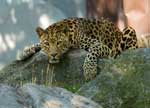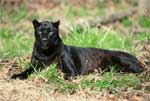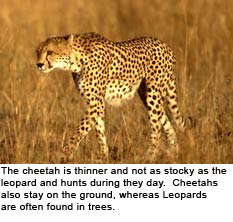|

Most leopards are light tan or fawn with black rosettes, but their coat color is highly variable. There are smaller rosettes and spots on the head.
 The African leopard is the most common subspecies leopard with the least conservation concern. The African leopard has an elongated body with relatively short, stocky legs. They have short rounded ears and long sensitive whiskers. Leopards have long tails which helps them to balance in trees. The African leopard varies in base color throughout Africa, depending on the location and habitat. They can vary from reddish brown, cream and dark yellow. The African leopard is the most common subspecies leopard with the least conservation concern. The African leopard has an elongated body with relatively short, stocky legs. They have short rounded ears and long sensitive whiskers. Leopards have long tails which helps them to balance in trees. The African leopard varies in base color throughout Africa, depending on the location and habitat. They can vary from reddish brown, cream and dark yellow.
 Black panthers: Some leopards are black and are often known as black panthers. This condition is known as melanism. Their spots can sometimes be seen in bright light. African leopards are covered in black rosettes. There are not normally spots within the rossetes. Each leopard's spots are unique in that their patterns are never the same. Male leopards are larger and heavier than females. Their weight can range anywhere from 55- 200 pounds. The leopard's claws are retractable and hooked for climbing trees and tearing prey. Black panthers: Some leopards are black and are often known as black panthers. This condition is known as melanism. Their spots can sometimes be seen in bright light. African leopards are covered in black rosettes. There are not normally spots within the rossetes. Each leopard's spots are unique in that their patterns are never the same. Male leopards are larger and heavier than females. Their weight can range anywhere from 55- 200 pounds. The leopard's claws are retractable and hooked for climbing trees and tearing prey.
Clouded Leopard:
The clouded leopard is a very mysterious animal that
few people have seen. Our information on them is limited to studies on captive ones, as they have rarely been able
to be studied in the wild. 
Size wise, they seem to be in between the size of the large cats and the size of the small cat species. They can roar, chuffle, hiss and growl like big cats, but they an also purr like small cats. They have the longest tail in relation to body size of any cat, and teeth as big as tiger's (even though tigers are ten times bigger in their body!) Their eyes are also are not quite like either the large cats(pupils able to get fully round) or small cats(pupils reduce to vertical slits). They are quite adaptable in their habitats and tend to be noctural and arboreal (living in the trees). They have the ability to climb upside down on tree branches!
Overall however, there is a lot left to be learned about clouded leopards - they live solitary and secretive lives and are very difficult for researchers to study. They also have the threat of habitat loss because of an increase in farms.
 Snow leopard: A snow leopard lives in cold, Snow leopard: A snow leopard lives in cold,
mountainous areas and pine forests in central Asia and has warm, grayish fur with some white, yellow brown and dark areas. It can live at extremely high elevations. It also has a long thick tail that helps them to balance in the snow, rocks and trees. They weigh between 55 - 150lbs and have small legs compared to the body. The snow leopard is mostly nocturnal and tends to stay away from humans. They don't tend to eat their food all at once like many other big cats - instead they will
revisit their kill over a few days.
These are just a few kinds of leopards - there are more!

Despite its size, this largely nocturnal and arboreal predator is difficult to see in the wild. The best location to see leopards in Africa is in the Sabi Sand Private Game Reserve in South Africa, where leopards are habituated to safari vehicles and are seen on a daily basis at very close range.
The big cats, especially the spotted cats, are easy to confuse for those who see them in captivity or in photographs. The leopard is closely related to, and appears very similar to, the jaguar; it is less often confused with the cheetah. The ranges, habitats, and activities of the three cats make them easy to distinguish in the wild.
Since wild leopards live only in Africa and Asia while wild jaguars live only in the Americas, there is no possibility of confusing them in the wild. There are also visual markings that set them apart. Leopards do not have the spots within the rosettes that jaguars always have, and the jaguar's spots are larger than the leopard's. The Amur leopard and the North Chinese leopard are occasional exceptions. The leopard is smaller and less stocky than the jaguar, although it is more heavyset than the cheetah.
Besides appearance, the leopard and jaguar have similar behavior patterns. Jaguars can adapt to a range of habitats from rainforest to ranchlands while leopards are even more adaptable ranging in from deserts and mountains, savanna and woodlands.
 The cheetah, although its range overlaps extensively with that of the leopard, is easily distinguished. The leopard is heavier, stockier, has a larger head in proportion to the body, and has rosettes rather than spots. The cheetah is the fastest of all the cats. The cheetah also has dark 'teardrop'-like markings running down the sides of its face, whereas the leopard does not. Cheetahs are usually diurnal, while leopards are more active at night (nocturnal); cheetahs are also exclusively terrestrial (except when young), while leopards
often climb trees. The cheetah, although its range overlaps extensively with that of the leopard, is easily distinguished. The leopard is heavier, stockier, has a larger head in proportion to the body, and has rosettes rather than spots. The cheetah is the fastest of all the cats. The cheetah also has dark 'teardrop'-like markings running down the sides of its face, whereas the leopard does not. Cheetahs are usually diurnal, while leopards are more active at night (nocturnal); cheetahs are also exclusively terrestrial (except when young), while leopards
often climb trees.
Diet: Leopards have a very varied diet which includes insects, rodents, reptiles, even large mammals. They sometimes take domestic livestock when other food is scarce. Leopards are very strong and they have been known to carry prey 2 to 3 times their own weight (such as Blue Wildebeest) up into trees. They are nocturnal and usually don’t hunt until dusk. However, they are opportunists and will hunt in the daylight when necessary.
African leopards inhabit all of Africa. This ranges from mountainous regions to grasslands and savannas. They also can live in desert and forest areas. They are very adaptable to their surroundings. They are incredibly resilient animals.
The biggest threat to the African leopard population is humans. They are hunted for their fur and sport and often killed for eating livestock. As the human population grows it creates more of a problem for them.

 A leopard's gestation period is usually between 90-112 days and they bear litters typically between 2-4 cubs. Leopard cubs stay with their mother for about 2 years. It is at about this age that they reach their sexual maturity. Male leopards roam a large territory so there is usually one leopard male with several females in his territory. The male marks his territory using feces, urine and facial marking and scrapings. A leopard's gestation period is usually between 90-112 days and they bear litters typically between 2-4 cubs. Leopard cubs stay with their mother for about 2 years. It is at about this age that they reach their sexual maturity. Male leopards roam a large territory so there is usually one leopard male with several females in his territory. The male marks his territory using feces, urine and facial marking and scrapings.

Originally, it was thought that a leopard was a hybrid between a lion and a panther, and the leopard's common name derives from this belief; leo is the greek and latin word for lion (greek leon) and pard is an old term meaning "panther. In fact, a "panther" can be any of several species of large felid. In North America panther means puma and in South America a panther is a jaguar. Elsewhere in the world a panther is a leopard. Early naturalists distinguished between leopards and panthers not by color (a common misconception), but by the length of the tail - panthers having longer tails than pards (leopards).
A black panther is a melanistic leopard (or melanistic jaguar). These have mutations that cause them to produce more black pigment (eumelanin) than orange-tan pigment (pheomelanin). This results in a chiefly black coat, though the spots of a black panther can still be discerned in certain light as the deposition of pigment is different in the pattern than in the background. There are also white panthers.
All text is available under the terms
of the GNU Free Documentation License
|